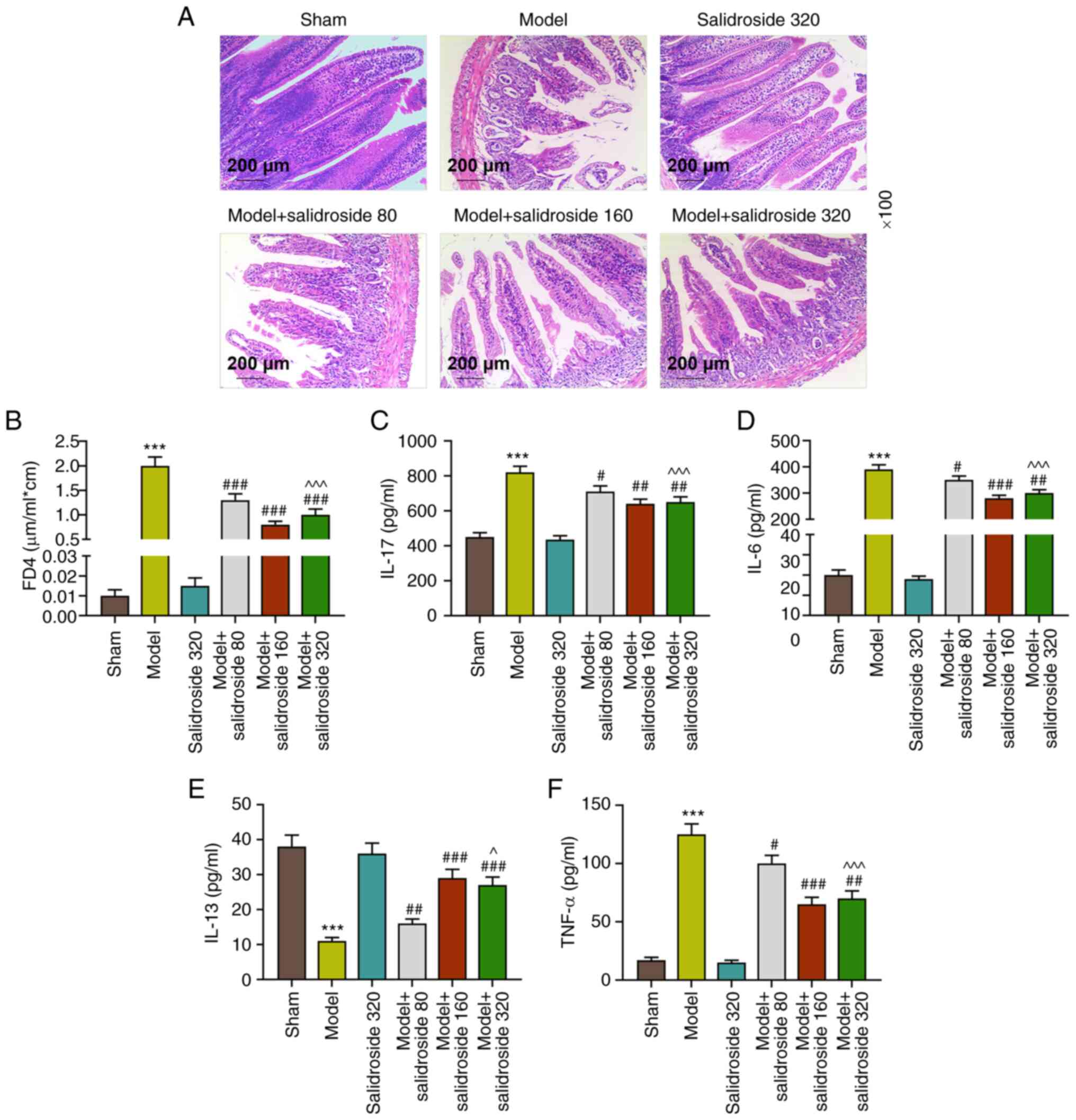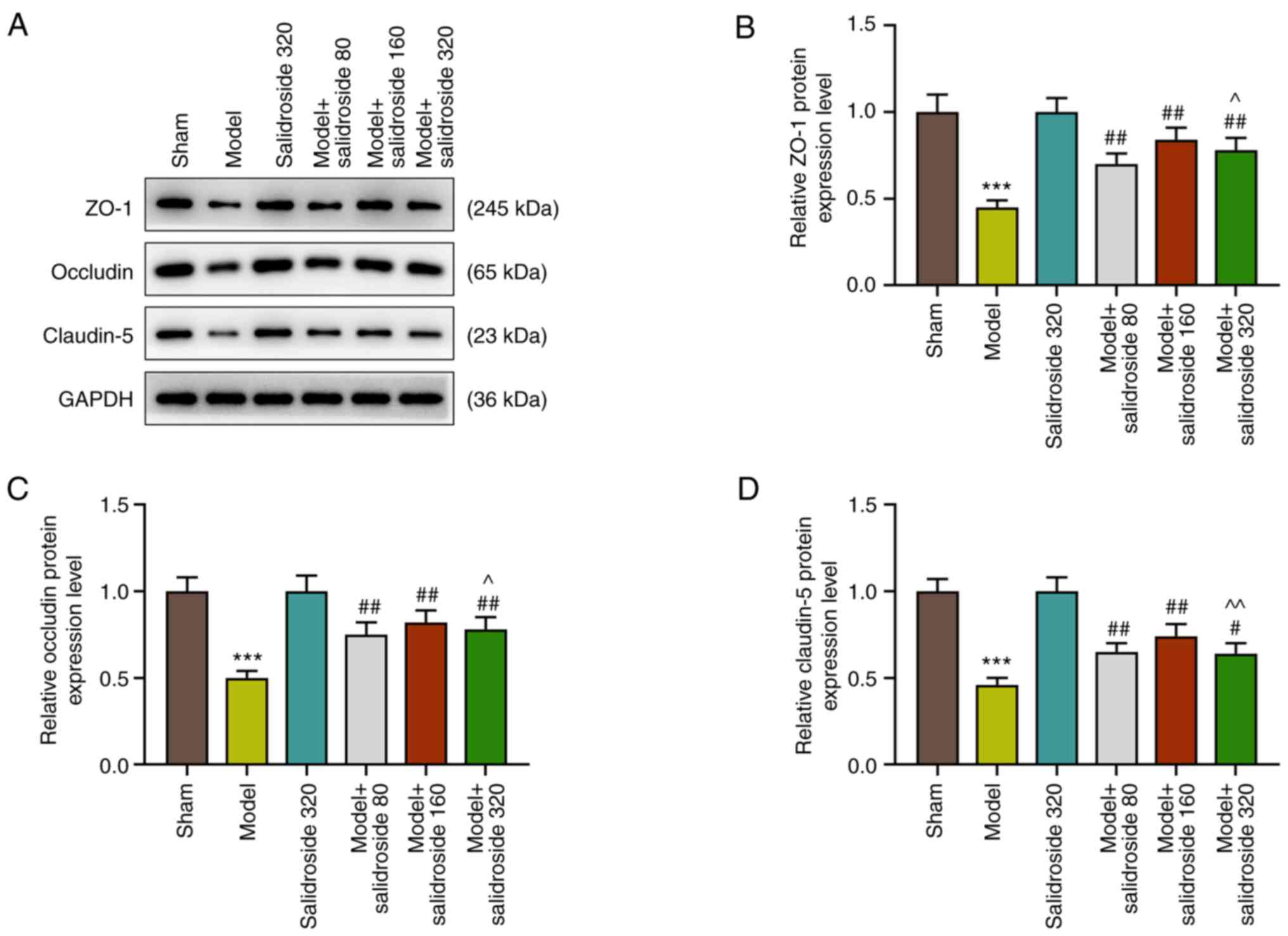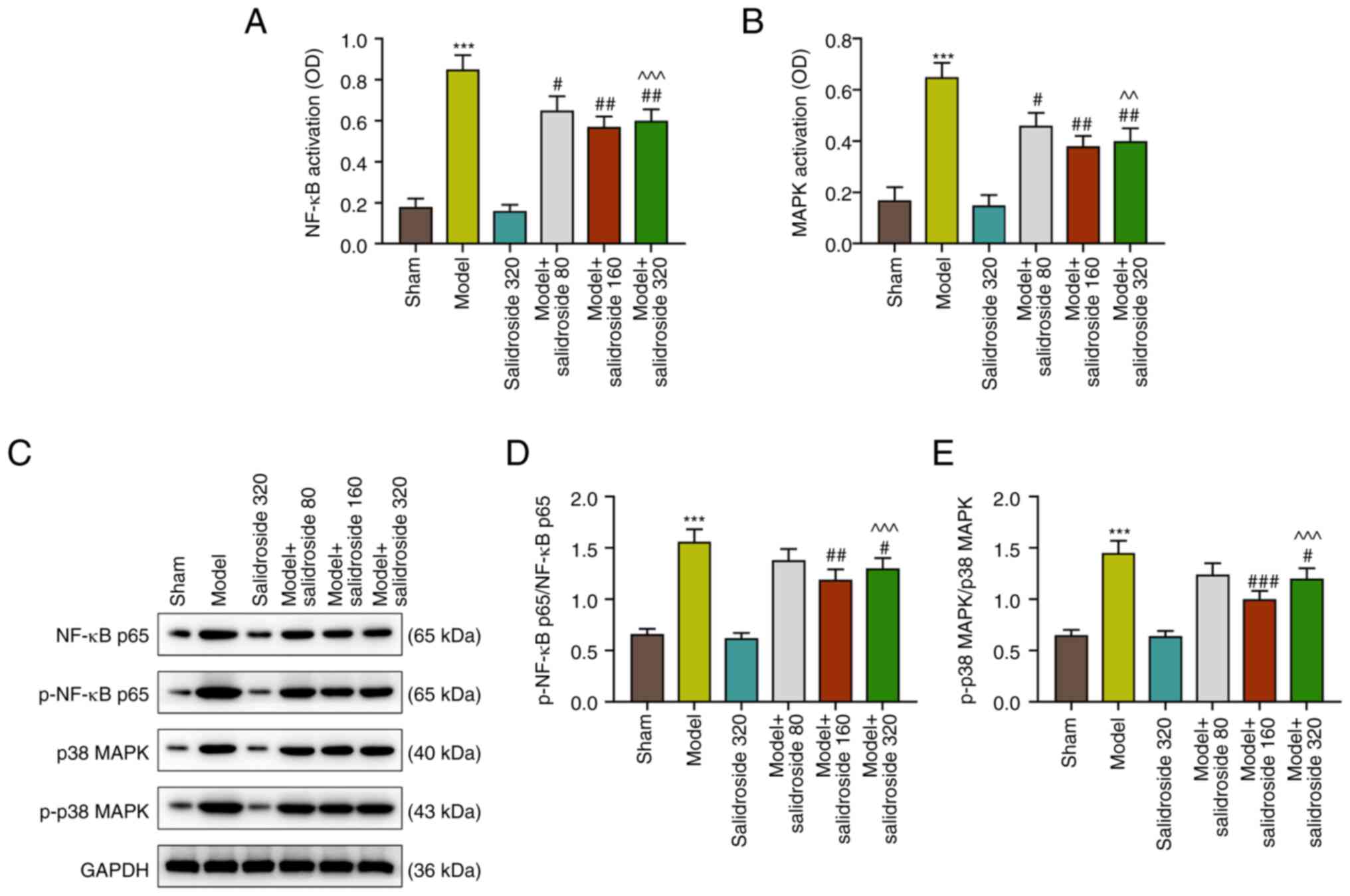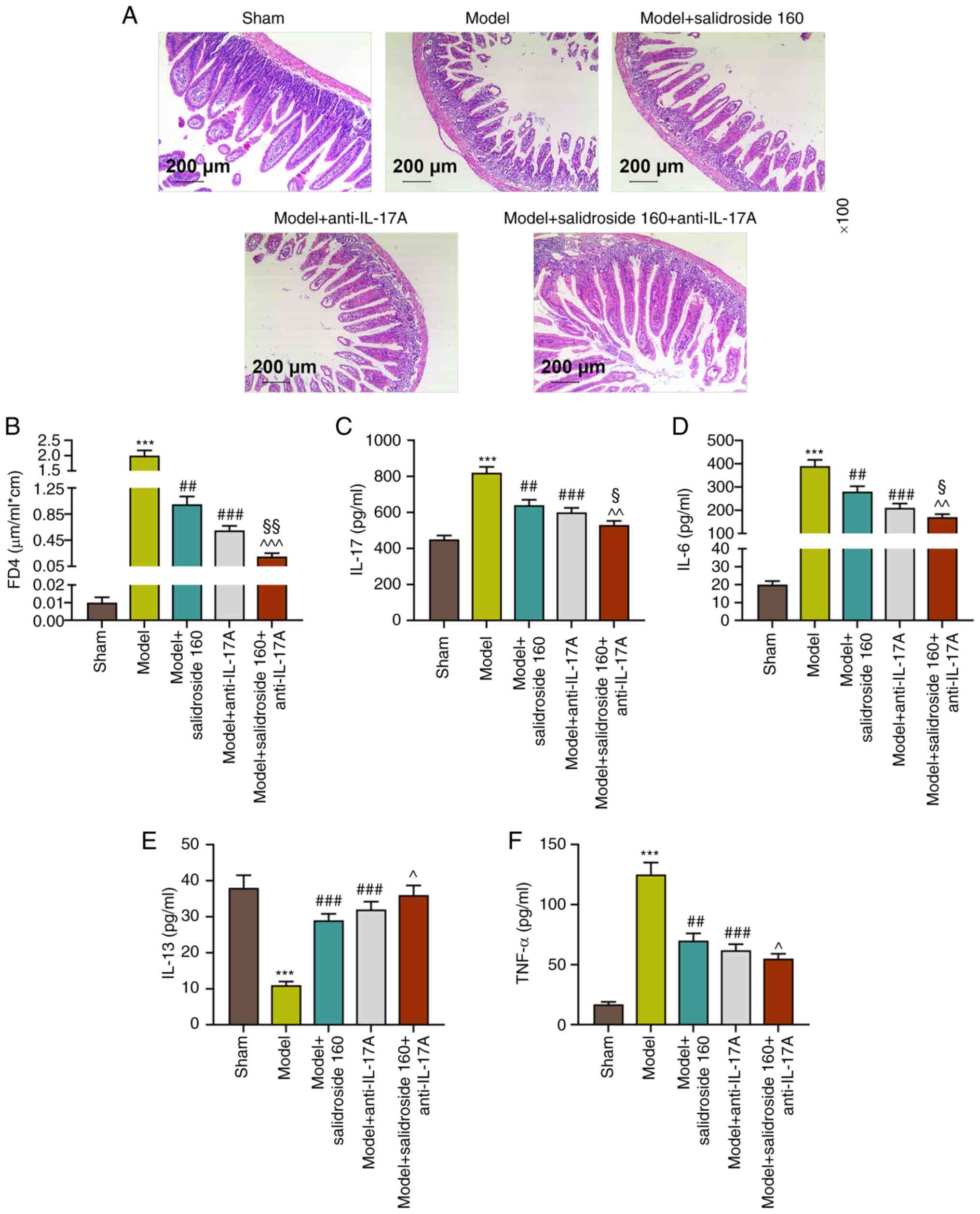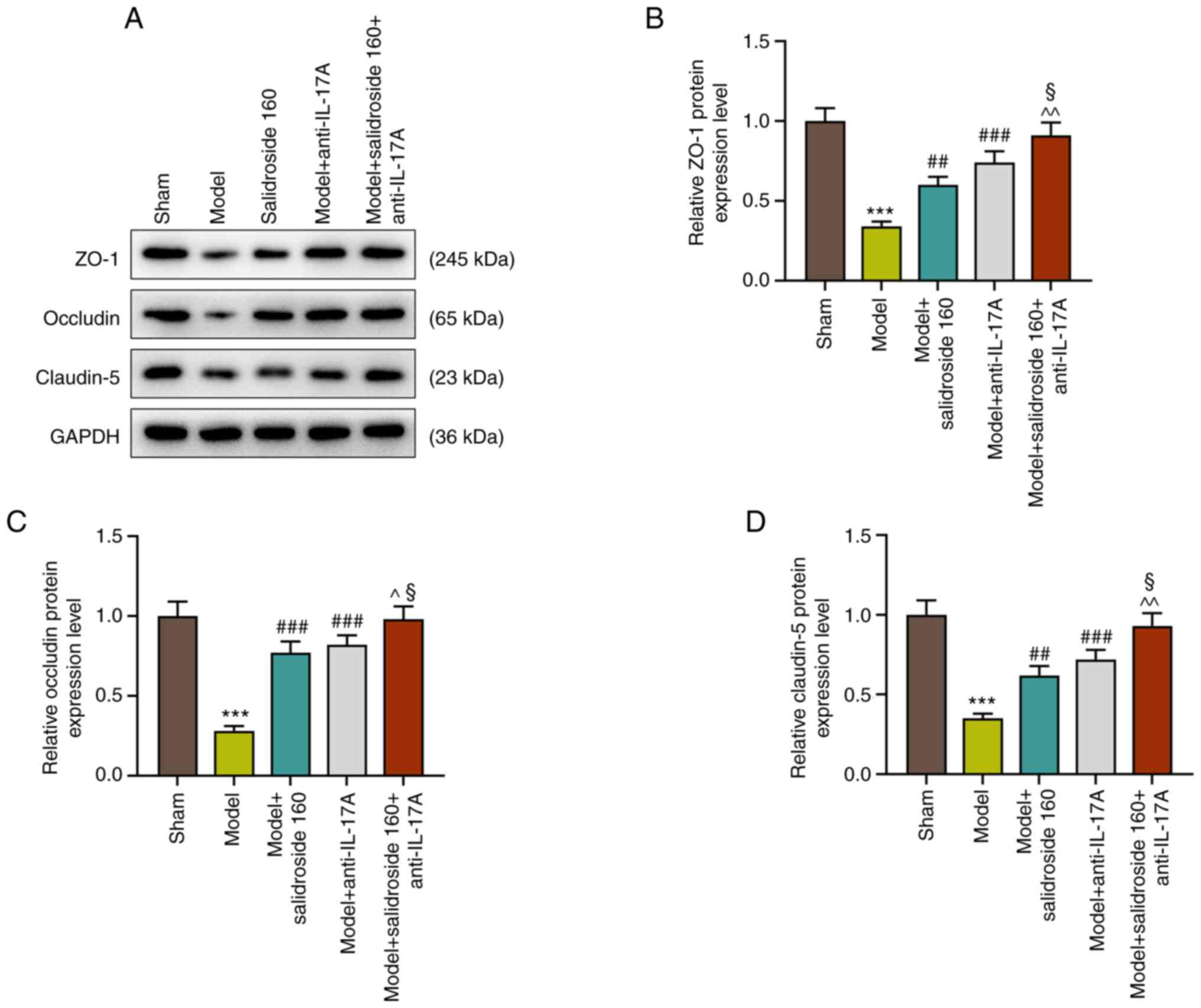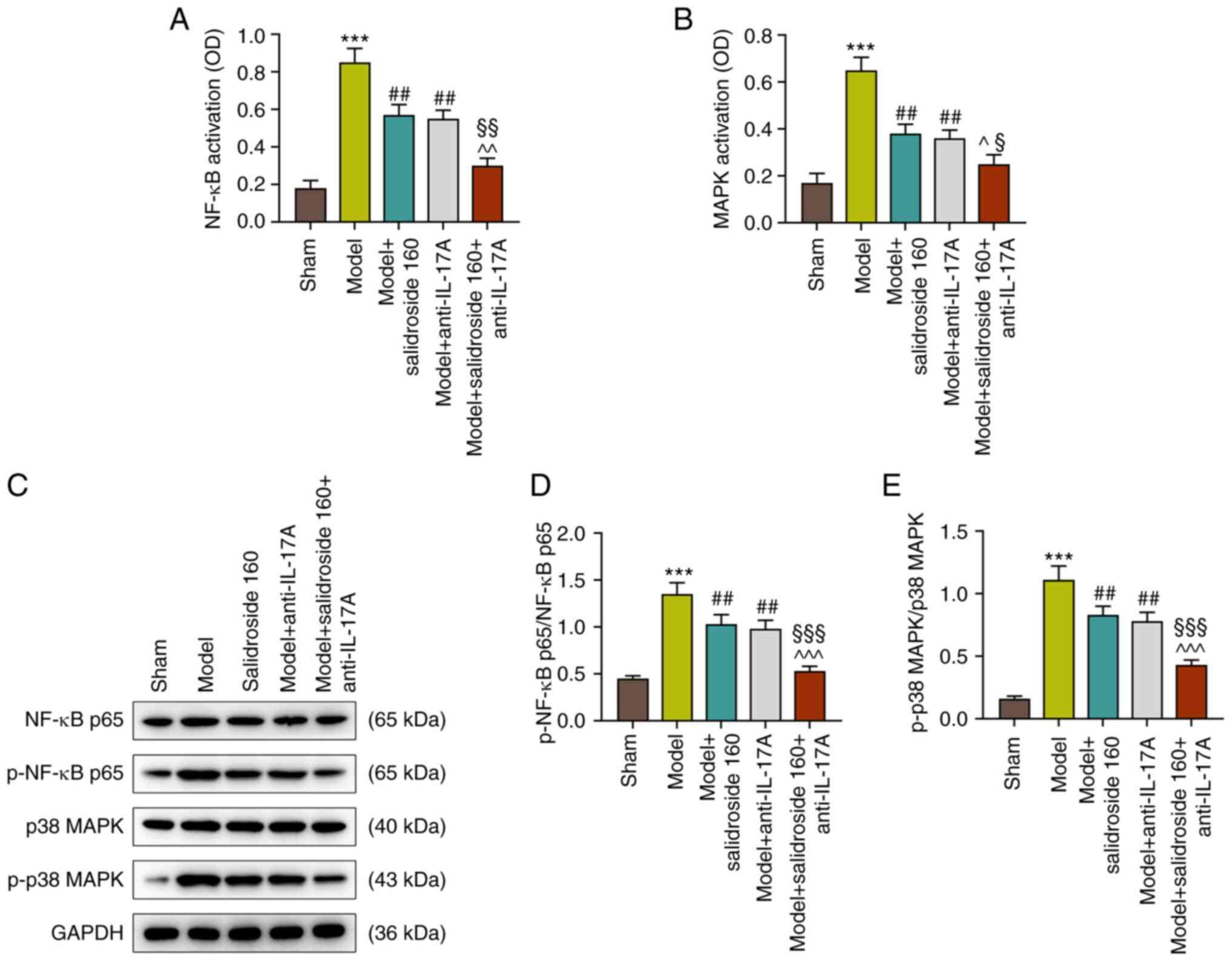|
1
|
Shankar-Hari M, Phillips GS, Levy ML,
Seymour CW, Liu VX, Deutschman CS, Angus DC, Rubenfeld GD and
Singer M: Developing a new definition and assessing new clinical
criteria for septic shock: For the third international consensus
definitions for sepsis and septic shock (Sepsis-3). JAMA.
315:775–787. 2016.PubMed/NCBI View Article : Google Scholar
|
|
2
|
Deutschman CS and Tracey KJ: Sepsis:
Current dogma and new perspectives. Immunity. 40:463–475.
2014.PubMed/NCBI View Article : Google Scholar
|
|
3
|
Hawiger J, Veach RA and Zienkiewicz J: New
paradigms in sepsis: From prevention to protection of failing
microcirculation. J Thromb Haemost. 13:1743–1756. 2015.PubMed/NCBI View Article : Google Scholar
|
|
4
|
Adib-Conquy M and Cavaillon JM: Host
inflammatory and anti-inflammatory response during sepsis. Pathol
Biol (Paris). 60:306–313. 2012.PubMed/NCBI View Article : Google Scholar : (In French).
|
|
5
|
de Medina FS, Romero-Calvo I, Mascaraque C
and Martínez-Augustin O: Intestinal inflammation and mucosal
barrier function. Inflamm Bowel Dis. 20:2394–2404. 2014.PubMed/NCBI View Article : Google Scholar
|
|
6
|
Panossian A, Wikman G and Sarris J:
Rosenroot (Rhodiola rosea): Traditional use, chemical composition,
pharmacology and clinical efficacy. Phytomedicine. 17:481–493.
2010.PubMed/NCBI View Article : Google Scholar
|
|
7
|
Xue F, Yang M and Ma L: Microbial
synthesis of salidroside. Sheng Wu Gong Cheng Xue Bao.
35:1184–1192. 2019.PubMed/NCBI View Article : Google Scholar
|
|
8
|
Zhou F, Ju J, Fang Y, Fan X, Yan S, Wang
Q, Wei P, Duan F, Miao F, Hu Z and Wang M: Salidroside protected
against MPP(+)-induced Parkinson's disease in PC12 cells by
inhibiting inflammation, oxidative stress and cell apoptosis.
Biotechnol Applied Biochem. 66:247–253. 2019.PubMed/NCBI View
Article : Google Scholar
|
|
9
|
Xu N, Huang F, Jian C, Qin L, Lu F, Wang
Y, Zhang Z and Zhang Q: Neuroprotective effect of salidroside
against central nervous system inflammation-induced cognitive
deficits: A pivotal role of sirtuin 1-dependent Nrf-2/HO-1/NF-κB
pathway. Phytother Res. 33:1438–1447. 2019.PubMed/NCBI View
Article : Google Scholar
|
|
10
|
Zhong Z, Han J, Zhang J, Xiao Q, Hu J and
Chen L: Pharmacological activities, mechanisms of action, and
safety of salidroside in the central nervous system. Drug Des Devel
Ther. 12:1479–1489. 2018.PubMed/NCBI View Article : Google Scholar
|
|
11
|
Hu R, Wang MQ, Ni SH, Wang M, Liu LY, You
HY, Wu XH, Wang YJ, Lu L and Wei LB: Salidroside ameliorates
endothelial inflammation and oxidative stress by regulating the
AMPK/NF-κB/NLRP3 signaling pathway in AGEs-induced HUVECs. Eur J
Pharmacol. 867(172797)2020.PubMed/NCBI View Article : Google Scholar
|
|
12
|
Zhong ZF, Han J, Zhang JZ, Xiao Q, Chen
JY, Zhang K, Hu J and Chen LD: Neuroprotective effects of
salidroside on cerebral ischemia/reperfusion-induced behavioral
impairment involves the dopaminergic system. Front Pharmacol.
10(1433)2019.PubMed/NCBI View Article : Google Scholar
|
|
13
|
Liu MW, Su MX, Qin LF, Liu X, Tian ML,
Zhang W and Wang YH: Effect of salidroside on lung injury by
upregulating peroxisome proliferator-activated receptor γ
expression in septic rats. Exp Ther Med. 7:1446–1456.
2014.PubMed/NCBI View Article : Google Scholar
|
|
14
|
Yasuda K, Takeuchi Y and Hirota K: The
pathogenicity of Th17 cells in autoimmune diseases. Semin
Immunopathol. 41:283–297. 2019.PubMed/NCBI View Article : Google Scholar
|
|
15
|
Gu C, Wu L and Li X: IL-17 family:
Cytokines, receptors and signaling. Cytokine. 64:477–485.
2013.PubMed/NCBI View Article : Google Scholar
|
|
16
|
Monin L and Gaffen SL: Interleukin 17
family cytokines: Signaling mechanisms, biological activities, and
therapeutic implications. Cold Spring Harbor perspect Biol.
10(a028522)2018.PubMed/NCBI View Article : Google Scholar
|
|
17
|
Kuwabara T, Ishikawa F, Kondo M and
Kakiuchi T: The role of IL-17 and related cytokines in inflammatory
autoimmune diseases. Mediators Inflamm.
2017(3908061)2017.PubMed/NCBI View Article : Google Scholar
|
|
18
|
Brembilla NC, Senra L and Boehncke WH: The
IL-17 family of cytokines in psoriasis: IL-17A and beyond. Front
Immunol. 9(1682)2018.PubMed/NCBI View Article : Google Scholar
|
|
19
|
Lubberts E: IL-17/Th17 targeting: On the
road to prevent chronic destructive arthritis? Cytokine. 41:84–91.
2008.PubMed/NCBI View Article : Google Scholar
|
|
20
|
Lubberts E, Koenders MI, Oppers-Walgreen
B, van den Bersselaar L, Coenen-de Roo CJ, Joosten LA and van den
Berg WB: Treatment with a neutralizing anti-murine interleukin-17
antibody after the onset of collagen-induced arthritis reduces
joint inflammation, cartilage destruction, and bone erosion.
Arthritis Rheum. 50:650–659. 2004.PubMed/NCBI View Article : Google Scholar
|
|
21
|
Li J, Kong P, Chen C, Tang J, Jin X, Yan J
and Wang Y: Targeting IL-17A improves the dysmotility of the small
intestine and alleviates the injury of the interstitial cells of
cajal during sepsis. Oxid Med Cell Longev.
2019(1475729)2019.PubMed/NCBI View Article : Google Scholar
|
|
22
|
Lee JS, Tato CM, Joyce-Shaikh B, Gulen MF,
Cayatte C, Chen Y, Blumenschein WM, Judo M, Ayanoglu G, McClanahan
TK, et al: Interleukin-23-independent IL-17 production regulates
intestinal epithelial permeability. Immunity. 43:727–738.
2015.PubMed/NCBI View Article : Google Scholar
|
|
23
|
Wei L, Xiong H, Li W, Li B and Cheng Y:
Upregulation of IL-6 expression in human salivary gland cell line
by IL-17 via activation of p38 MAPK, ERK, PI3K/Akt, and NF-κB
pathways. J Oral Pathol Med. 47:847–855. 2018.PubMed/NCBI View Article : Google Scholar
|
|
24
|
Chang SL, Hsiao YW, Tsai YN, Lin SF, Liu
SH, Lin YJ, Lo LW, Chung FP, Chao TF, Hu YF, et al: Interleukin-17
enhances cardiac ventricular remodeling via activating MAPK pathway
in ischemic heart failure. J Mol Cell Cardiol. 122:69–79.
2018.PubMed/NCBI View Article : Google Scholar
|
|
25
|
Wei L, Liu M, Xiong H and Peng B:
Up-regulation of IL-23 expression in human dental pulp fibroblasts
by IL-17 via activation of the NF-κB and MAPK pathways. Int Endod
J. 51:622–631. 2018.PubMed/NCBI View Article : Google Scholar
|
|
26
|
Johansen C, Kragballe K, Westergaard M,
Henningsen J, Kristiansen K and Iversen L: The mitogen-activated
protein kinases p38 and ERK1/2 are increased in lesional psoriatic
skin. Br J Dermatol. 152:37–42. 2005.PubMed/NCBI View Article : Google Scholar
|
|
27
|
Chen H, Wang X, Yan X, Cheng X, He X and
Zheng W: LncRNA MALAT1 regulates sepsis-induced cardiac
inflammation and dysfunction via interaction with miR-125b and p38
MAPK/NFκB. Int Immunopharmacol. 55:69–76. 2018.PubMed/NCBI View Article : Google Scholar
|
|
28
|
Cai X, Chen Y, Xie X, Yao D, Ding C and
Chen M: Astaxanthin prevents against lipopolysaccharide-induced
acute lung injury and sepsis via inhibiting activation of
MAPK/NF-κB. Am J Transl Res. 11:1884–1894. 2019.PubMed/NCBI
|
|
29
|
Lan KC, Chao SC, Wu HY, Chiang CL, Wang
CC, Liu SH and Weng TI: Salidroside ameliorates sepsis-induced
acute lung injury and mortality via downregulating NF-κB and HMGB1
pathways through the upregulation of SIRT1. Sci Rep.
7(12026)2017.PubMed/NCBI View Article : Google Scholar
|
|
30
|
Zhang XR, Fu XJ, Zhu DS, Zhang CZ, Hou S,
Li M and Yang XH: Salidroside-regulated lipid metabolism with
down-regulation of miR-370 in type 2 diabetic mice. Eur J
Pharmacol. 779:46–52. 2016.PubMed/NCBI View Article : Google Scholar
|
|
31
|
Yang ZR, Wang HF, Zuo TC, Guan LL and Dai
N: Salidroside alleviates oxidative stress in the liver with
non-alcoholic steatohepatitis in rats. BMC Pharmacol Toxicol.
17(16)2016.PubMed/NCBI View Article : Google Scholar
|
|
32
|
Uhle F, Lichtenstern C, Brenner T and
Weigand MA: Pathophysiology of sepsis. Anasthesiol Intensivmed
Notfallmed Schmerzther. 50:114–122. 2015.PubMed/NCBI View Article : Google Scholar
|
|
33
|
Hu Q, Ren H, Li G, Wang D, Zhou Q, Wu J,
Zheng J, Huang J, Slade DA, Wu X and Ren J: STING-mediated
intestinal barrier dysfunction contributes to lethal sepsis.
EBioMedicine. 41:497–508. 2019.PubMed/NCBI View Article : Google Scholar
|
|
34
|
Liu S, Yu X, Hu B, Zou Y, Li J, Bo L and
Deng X: Salidroside rescued mice from experimental sepsis through
anti-inflammatory and anti-apoptosis effects. J Surg Res.
195:277–283. 2015.PubMed/NCBI View Article : Google Scholar
|
|
35
|
He H, Chang X, Gao J, Zhu L, Miao M and
Yan T: Salidroside mitigates sepsis-induced myocarditis in rats by
regulating IGF-1/PI3K/Akt/GSK-3β signaling. Inflammation.
38:2178–2184. 2015.PubMed/NCBI View Article : Google Scholar
|
|
36
|
Liu F, Liu J, Liu Y, Zhang Y and Ding X:
Shen-Fu Decoction could ameliorate intestinal permeability by
regulating the intestinal expression of tight junction proteins and
p-VASP in septic rats. J Ethnopharmacol. 268(113562)2021.PubMed/NCBI View Article : Google Scholar
|
|
37
|
Wang L, Cui YL, Zhang Z, Lin ZF and Chen
DC: Rhubarb monomers protect intestinal mucosal barrier in sepsis
via junction proteins. Chin Med J (Engl). 130:1218–1225.
2017.PubMed/NCBI View Article : Google Scholar
|
|
38
|
Li Y, Guo R, Zhang M, Chen P, Li J and Sun
Y: Protective effect of emodin on intestinal epithelial tight
junction barrier integrity in rats with sepsis induced by cecal
ligation and puncture. Exp Ther Med. 19:3521–3530. 2020.PubMed/NCBI View Article : Google Scholar
|
|
39
|
Kumar V and Sharma A: Innate immunity in
sepsis pathogenesis and its modulation: New immunomodulatory
targets revealed. J Chemother. 20:672–683. 2008.PubMed/NCBI View Article : Google Scholar
|
|
40
|
Cao YZ, Tu YY, Chen X, Wang BL, Zhong YX
and Liu MH: Protective effect of Ulinastatin against murine models
of sepsis: Inhibition of TNF-α and IL-6 and augmentation of IL-10
and IL-13. Exp Toxicol Pathol. 64:543–547. 2012.PubMed/NCBI View Article : Google Scholar
|
|
41
|
Lv R, Zhao J, Lei M, Xiao D, Yu Y and Xie
J: IL-33 attenuates sepsis by inhibiting IL-17 receptor signaling
through upregulation of SOCS3. Cell Physiol Biochem. 42:1961–1972.
2017.PubMed/NCBI View Article : Google Scholar
|
|
42
|
Franco DM, Arevalo-Rodriguez I, Roqué IFM,
Oleas NG, Nuvials X and Zamora J: Plasma interleukin-6
concentration for the diagnosis of sepsis in critically ill adults.
Cochrane Database Syst Rev. 4(CD011811)2019.PubMed/NCBI View Article : Google Scholar
|
|
43
|
Newham P, Ross D, Ceuppens P, Das S, Yates
JW, Betts C, Reens J, Randall KJ, Knight R and McKay JS:
Determination of the safety and efficacy of therapeutic
neutralization of tumor necrosis factor-α (TNF-α) using AZD9773, an
anti-TNF-α immune Fab, in murine CLP sepsis. Inflamm Res.
63:149–160. 2014.PubMed/NCBI View Article : Google Scholar
|
|
44
|
Collighan N, Giannoudis PV, Kourgeraki O,
Perry SL, Guillou PJ and Bellamy MC: Interleukin 13 and
inflammatory markers in human sepsis. Br J Surg. 91:762–768.
2004.PubMed/NCBI View Article : Google Scholar
|
|
45
|
Chen L, Liu P, Feng X and Ma C:
Salidroside suppressing LPS-induced myocardial injury by inhibiting
ROS-mediated PI3K/Akt/mTOR pathway in vitro and in vivo. J Cell Mol
Med. 21:3178–3189. 2017.PubMed/NCBI View Article : Google Scholar
|
|
46
|
Hsiao YW, Tsai YN, Huang YT, Liu SH, Lin
YJ, Lo LW, Hu YF, Chung FP, Lin SF, Chang SL, et al: Rhodiola
crenulata reduces ventricular arrhythmia through mitigating the
activation of IL-17 and inhibiting the MAPK signaling pathway.
Cardiovasc Drugs Ther. 35:889–900. 2020.PubMed/NCBI View Article : Google Scholar
|
|
47
|
Yan GH and Choi YH: Salidroside attenuates
allergic airway inflammation through negative regulation of nuclear
factor-kappa B and p38 mitogen-activated protein kinase. J
Pharmacol Sci. 126:126–135. 2014.PubMed/NCBI View Article : Google Scholar
|
|
48
|
Liu J, Liu F, Liang T, Cao P, Li J, Zhang
Y and Liu Y: Efficacy of Shenfu decoction on sepsis in rats with
condition induced by cecal ligation and puncture. J Tradit Chin
Med. 40:621–628. 2020.PubMed/NCBI View Article : Google Scholar
|
|
49
|
Xie S, Yang T, Wang Z, Li M, Ding L, Hu X
and Geng L: Astragaloside IV attenuates sepsis-induced intestinal
barrier dysfunction via suppressing RhoA/NLRP3 inflammasome
signaling. Int Immunopharmacol. 78(106066)2020.PubMed/NCBI View Article : Google Scholar
|
|
50
|
Meng ZJ, Wang C, Meng LT, Bao BH, Wu JH
and Hu YQ: Sodium tanshinone IIA sulfonate attenuates cardiac
dysfunction and improves survival of rats with cecal ligation and
puncture-induced sepsis. Chin J Nat Med. 16:846–855.
2018.PubMed/NCBI View Article : Google Scholar
|
|
51
|
Hwang JS, Kim KH, Park J, Kim SM, Cho H,
Lee Y and Han IO: Glucosamine improves survival in a mouse model of
sepsis and attenuates sepsis-induced lung injury and inflammation.
J Biol Chem. 294:608–622. 2019.PubMed/NCBI View Article : Google Scholar
|
|
52
|
Sun S, Wang J, Wang J, Wang F, Yao S and
Xia H: Maresin 1 mitigates sepsis-associated acute kidney injury in
mice via inhibition of the NF-κB/STAT3/MAPK pathways. Front
Pharmacol. 10(1323)2019.PubMed/NCBI View Article : Google Scholar
|
|
53
|
Chang NC, Yeh CT, Lin YK, Hu P, Kuo KT,
Fong IH, Kounis NG, Hu P and Hung MY: Garcinol attenuates
lipoprotein(a)-induced oxidative stress and inflammatory cytokine
production in ventricular cardiomyocyte through α7-nicotinic
acetylcholine receptor-mediated inhibition of the p38 MAPK and
NF-κB signaling pathways. Antioxidants (Basel).
10(461)2021.PubMed/NCBI View Article : Google Scholar
|
|
54
|
Chen Q, Lu H, Duan C, Zhu X, Zhang Y, Li M
and Zhang D: PDCD4 simultaneously promotes microglia activation via
PDCD4-MAPK-NF-κB positive loop and facilitates neuron apoptosis
during neuroinflammation. Inflammation. 45:234–252. 2022.PubMed/NCBI View Article : Google Scholar
|
|
55
|
Jarisarapurin W, Kunchana K,
Chularojmontri L and Wattanapitayakul SK: Unripe carica papaya
protects methylglyoxal-invoked endothelial cell inflammation and
apoptosis via the suppression of oxidative stress and
Akt/MAPK/NF-κB signals. Antioxidants (Basel).
10(1158)2021.PubMed/NCBI View Article : Google Scholar
|
|
56
|
Weber SU, Schewe JC, Putensen C, Stüber F
and Schröder S: Apoptosis as a pathomechanism in sepsis.
Anaesthesist. 53:59–65. 2004.PubMed/NCBI View Article : Google Scholar : (In German).
|
|
57
|
Li R, Guo Y, Zhang Y, Zhang X, Zhu L and
Yan T: Salidroside ameliorates renal interstitial fibrosis by
inhibiting the TLR4/NF-κB and MAPK signaling pathways. Int J Mol
Sci. 20(1103)2019.PubMed/NCBI View Article : Google Scholar
|
|
58
|
Hata K, Andoh A, Shimada M, Fujino S,
Bamba S, Araki Y, Okuno T, Fujiyama Y and Bamba T: IL-17 stimulates
inflammatory responses via NF-kappaB and MAP kinase pathways in
human colonic myofibroblasts. Am J Physiol Gastrointestinal Liver
Physiol. 282:G1035–G1044. 2002.PubMed/NCBI View Article : Google Scholar
|
|
59
|
Hwang SY, Kim JY, Kim KW, Park MK, Moon Y,
Kim WU and Kim HY: IL-17 induces production of IL-6 and IL-8 in
rheumatoid arthritis synovial fibroblasts via NF-kappaB- and
PI3-kinase/Akt-dependent pathways. Arthritis Res Ther. 6:R120–R128.
2004.PubMed/NCBI View
Article : Google Scholar
|
|
60
|
He S, Zhao J, Xu X, Cui X, Wang N, Han X,
Guo Y and Liu Q: Uncovering the molecular mechanism of the
Qiang-Xin 1 formula on sepsis-induced cardiac dysfunction based on
systems pharmacology. Oxid Med Cell Longev.
2020(3815185)2020.PubMed/NCBI View Article : Google Scholar
|















